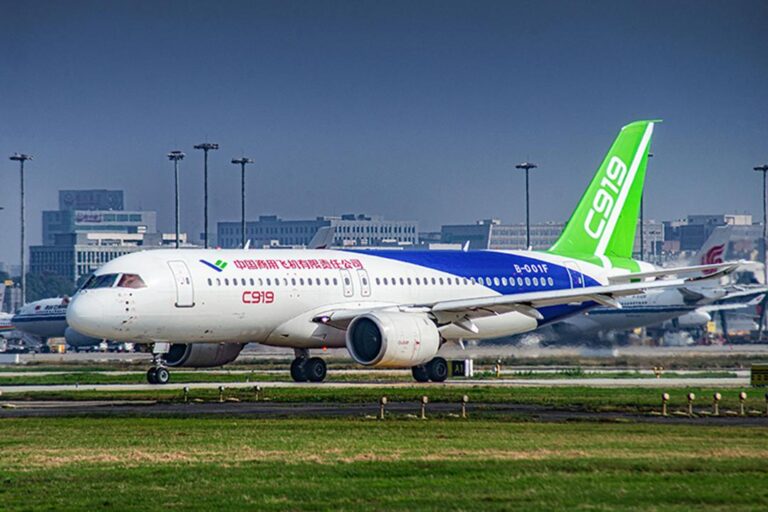The manufacturer of China’s flagship C919 commercial jet is set to seek new buyers in the Middle East at the upcoming Dubai Airshow, as part of its broader strategy to expand the aircraft’s global footprint. The South China Morning Post reports that this move underscores China’s ambitions to challenge the dominance of established aerospace giants by penetrating emerging markets with its domestically developed narrow-body airliner. With the Dubai Airshow serving as a key platform for aerospace deals and collaborations, the C919’s producer aims to showcase the jet’s capabilities and secure orders from airlines in the strategically important Middle Eastern region.
China’s COMAC targets Middle Eastern market expansion at Dubai Airshow
COMAC, the manufacturer behind China’s flagship C919 narrow-body airliner, is intensifying efforts to penetrate the Middle Eastern aviation market during the Dubai Airshow. Positioned as a cost-competitive alternative to Western-made jets, the C919 aims to attract regional airlines seeking modern, fuel-efficient aircraft to add to their fleet. With the Middle East’s rapid urban growth and expanding travel demand, COMAC is targeting carriers eager to diversify their fleets amid shifting geopolitical and economic dynamics.
At the event, COMAC representatives highlighted several key benefits of the C919:
- Fuel efficiency: Advanced aerodynamic design contributing to lower operating costs.
- Passenger comfort: Spacious cabin layout tailored for short to medium-haul routes.
- Competitive pricing: Lower acquisition and maintenance costs compared to Western rivals.
The company also unveiled preliminary deals under negotiation with regional operators, signaling a strategic push to establish a foothold in one of the world’s fastest-growing aviation hubs.
| Feature | C919 | Competitor Average |
|---|---|---|
| Seating Capacity | 158 – 174 | 160 – 180 |
| Range (km) | 5,555 | 5,400 |
| Fuel Burn (per seat) | 4.5 L/100km | 5.0 L/100km |
| List Price (approx.) | $50 million | $55 million |
Strategic benefits and challenges for C919 adoption in the Gulf aviation sector
The introduction of the C919 into the Gulf aviation market presents compelling strategic advantages. Airlines in this region, keen on diversifying their fleets and reducing dependence on Western manufacturers, may find the C919’s competitive pricing and fuel efficiency attractive. Its modern avionics and compliance with international safety standards position it as a suitable contender for short and medium-haul routes, aligning with Gulf carriers’ expansion plans into new regional markets. Moreover, adoption of the C919 could foster closer China-Gulf economic ties, enhancing bilateral trade and technology collaboration in aerospace sectors.
However, challenges persist that could temper enthusiasm for rapid integration. Service infrastructure and aftersales support remain primary concerns, as Gulf operators demand seamless maintenance networks and part availability. Additionally, geopolitical sensitivities and certification acceptance from agencies outside China might delay regulatory approvals, complicating fleet deployment strategies. Gulf airlines and leasing companies must weigh these factors against potential cost savings and geopolitical benefits.
| Strategic Factors | Benefits | Challenges |
|---|---|---|
| Cost | Lower acquisition price | Long-term maintenance costs uncertain |
| Fleet Diversification | Reduced dependence on Boeing/Airbus | Limited operational track record |
| Support & Infrastructure | Potential China-backed service facilities | Currently sparse MRO networks in Gulf |
- Geopolitical alliances: Aligning with China can bring political benefits but also risks.
- Certification hurdles: Securing international approvals may delay market entry.
- Market readiness: Gulf carriers’ operational models and passenger expectations will influence adoption speed.
Key considerations for Middle Eastern buyers evaluating the C919 jet’s performance and cost-effectiveness
Middle Eastern airlines and investors assessing the C919 jet are placing a strong emphasis on operational reliability and maintenance infrastructure. Given the region’s harsh desert climate, the aircraft’s adaptability to high temperatures and dusty conditions is critically evaluated. Buyers also scrutinize the availability of local support services and spare parts, as these influence aircraft downtime and long-term cost savings. Additionally, compatibility with regional airport facilities and air traffic control systems constitutes a key factor in decision-making, ensuring seamless integration into existing fleets.
Cost-effectiveness remains a pivotal concern amid fluctuating fuel prices and budget pressures. The C919’s fuel efficiency and competitive list price offer promising advantages; however, Middle Eastern buyers balance these benefits against factors such as training requirements for crew and technicians, financing options, and potential resale value. Below is a simplified comparison table highlighting primary considerations alongside regional priorities:
| Evaluation Criteria | Middle Eastern Priority | C919 Position |
|---|---|---|
| Fuel Efficiency | High | Competitive |
| Maintenance Network | Critical | Developing |
| Operational Range | Medium | Sufficient |
| Purchase Price | High | Attractive |
| Resale Value | Medium | Uncertain |
Key Takeaways
As the Dubai Airshow approaches, the Commercial Aircraft Corporation of China (COMAC) aims to broaden the C919’s international footprint by engaging potential buyers across the Middle East. With the region’s growing aviation market and increasing demand for modern, efficient aircraft, COMAC’s efforts at the event underscore China’s ambition to challenge established aerospace players on the global stage. Industry watchers will be closely monitoring how the C919 fares in this critical region, which could significantly influence the jet’s prospects beyond its domestic market.




